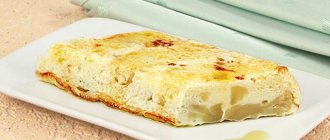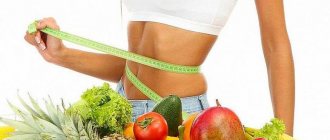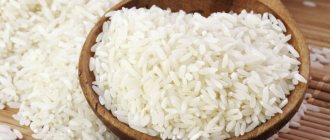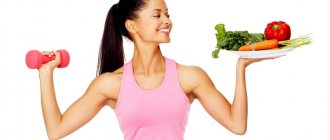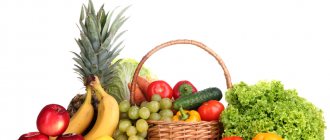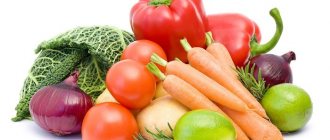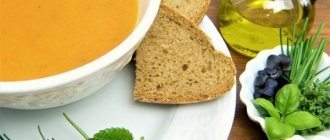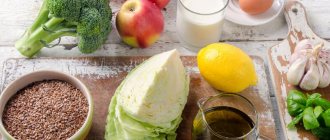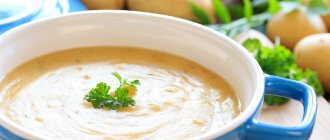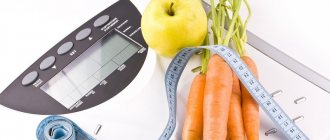Reference
Renal failure is a pathological condition in which the ability of the kidneys to form or excrete urine is partially or completely lost, resulting in disturbances in the water-salt, acid-base and osmotic homeostasis of the body, which lead to damage to all body systems. Kidney diseases lead to metabolic disorders. A special gentle diet, which doctors call “Table number 7,” can help the body. This nutritional system will restore the water-salt balance and allow you to cope with constant swelling of the legs, which is often a constant “companion” of kidney disease.
Subtleties of the “kidney” diet
Meat and fish dishes are best cooked boiled and then baked or fried.
The calorie content of the diet should be at least 3500 kcal per day.
It is advisable to take food 4–6 times a day.
All food is prepared with virtually no salt. In case of renal failure, no more than 2–3 g of salt per day is recommended, but patients with high blood pressure should prepare food without any salt at all.
The volume of liquid per day should not exceed 0.8–1 liters.
Kidney diseases: what are they and how to avoid them
More details
Nutrition for nephrotic syndrome
Therapeutic nutrition for nephrotic syndrome is aimed at combating hypoproteinemia, edema and other metabolic disorders while sparing the kidneys as much as possible.
Hypoproteinemia and its role in the genesis of edema dictates the need for sufficient glomerular filtration to introduce an increased amount of protein (1.3-1.5 g per 1 kg of body weight per day). An increase in protein content in the blood plasma helps to increase its oncotic pressure and reduce edema. It is especially advisable to introduce complete and easily digestible proteins (meat, fish, cottage cheese, egg whites). With a decrease in glomerular filtration with the subsequent development of azotemia, the amount of protein in the diet should be limited.
Salt-free diet
Since sodium is retained in tissues and plays an important role in the genesis of edema, the amount of salt in the diet is sharply limited. Food is prepared without salt. Special salt-free bread is used, foods rich in salt (herring, pickles, marinades, etc.) are excluded. However, long-term use of a salt-free diet can lead to the development of chloropenic azotemia, impaired renal function, hyperaldosteronism, and the appearance of edema that cannot be treated with diuretics. In order to prevent these phenomena, it is recommended to give patients 3-4 g of salt once a week on a salt-free diet. In the stage of polyuria, with a decrease in edema, it is allowed to increase the amount of salt up to the norm, since sodium is lost in large quantities in the urine.
Potassium
The potassium content in the diet should be sufficient, since the body loses a lot of it. Potassium helps displace sodium, and along with it, fluid from the body and reduce swelling. It is especially important to enrich the diet with potassium salts when using diuretics that promote the removal of potassium from the body (dichlorothiazide, furosemide, etc.). However, when diuresis decreases to less than 500 ml, potassium must be administered more carefully, as it accumulates in the body and can have a toxic effect. During this period, it is advisable to monitor the potassium content in the blood. Vegetables and fruits are especially rich in potassium salts.
Liquids
Against the background of a salt-free diet, the amount of liquid consumed by the patient is not significantly limited. Its amount should correspond to diuresis plus 500 ml (extrarenal losses). In the presence of hyperlipidemia, the amount of fat is somewhat limited, mainly due to animal fats rich in cholesterol, partially replacing them with vegetable oils. It is necessary to enrich the diet with lipotropic substances.
What's not allowed?
A diet for kidney failure involves not only the usual restrictions on spicy foods, spices and alcohol, but also limiting the amount of protein in food, since it produces toxins that should be neutralized by the kidneys. Reducing protein in the diet leads to improved well-being.
At the same time, some sources of protein are allowed in the “renal” diet, for example, eggs, lean meats, poultry, fish, but the amount of these products in the diet is prescribed by the attending physician.
Also, those following therapeutic diet number 7 should be completely excluded from the diet.:
- meat, fish and mushroom broths, legume broths;
- fatty meats and poultry, fried and stewed dishes without boiling, sausages, sausages, smoked meats, canned food;
- fatty fish, salted and smoked fish, caviar, canned food;
- cheeses, legumes in any form and chocolate;
- Among vegetables, onions, garlic, radishes, radishes, sorrel, spinach, salted, pickled and pickled vegetables, and mushrooms are prohibited;
- spicy and fatty snacks, canned food, smoked meats, caviar, meat, fish and mushroom sauces, pepper, mustard and horseradish are prohibited;
- Strong coffee, cocoa and mineral waters rich in sodium are contraindicated.
Both the mind and the kidneys. What food does our organs like?
More details
Dietary nutrition at different stages of CKD
As already mentioned, the diet at pre-dialysis (1–4) stages of chronic kidney disease is low in protein, with a decrease in the consumption of foods containing large amounts of phosphorus, potassium, sodium (salt), but with sufficient calorie content. It is necessary to strictly monitor the amount of fluid consumed.
Compliance with this recommendation somewhat improves the prognosis by slowing down the rate of fibrosis of renal tissue. This is confirmed by the results of clinical studies conducted repeatedly in different countries.
In stage 1 CKD, adult patients usually do not require protein restriction; a daily protein intake of 1.0 g/kg body weight can be taken as the norm. This will account for about 13% of the total energy supply. But children with CKD should receive the full age-appropriate amount of protein per day, which will prevent them from falling behind in mental and physical development. The calorie content of the diet should not exceed 35 kcal/kg/day, the amount of liquid consumed should not exceed 2 l/day. Sodium intake is limited to 2.4 g/day. Restrictions on potassium intake (its content in the diet is 4 g/day or more) and phosphorus are not required. When preparing a diet, preference should be given to vegetable fats and complex carbohydrates.
In stage 2 of chronic kidney disease, protein intake is usually somewhat limited (not lower than 0.8 g/kg/day). The diet includes regular foods. About 60% of the protein should be proteins of high biological value (meat, fish, soy protein, egg protein). The energy value of the diet is 35 kcal/kg/day (55% carbohydrates, 35% fats). Polyunsaturated fats and complex carbohydrates have an advantage; foods high in cholesterol are limited. The intake of sodium, water, phosphorus and potassium is the same as in the first stage of CKD.
The diet for CKD stages 3-4 is adjusted so that the daily protein intake averages 0.6 g/kg of recommended body weight. More stringent restrictions are irrational and can lead to a deterioration in the condition of a person with CKD and the possible development of malnutrition (MN). Diets with a more severe protein restriction are recommended for short courses (about a month) only in patients who are not able to undergo dialysis treatment in the near future. Such approaches to therapeutic nutrition partially relieve the symptoms of uremia (nausea, vomiting, itching, etc.). In order not to reduce the calorie content of the diet (at least 30 kcal/kg/day), it is recommended to increase the amount of vegetable fats and carbohydrates (both complex and refined) in the diet.
At these stages, efforts are also aimed at identifying and treating complications, mainly arterial hypertension. Along with mandatory drug therapy, sodium intake is more strictly limited (2.3-2.4 g/day) and fluid intake to 2 l/day with preserved diuresis. In some cases (for example, with malignant arterial hypertension), the doctor recommends completely eliminating table salt from the diet. When diuresis (oliguria) decreases, it is recommended to consume 400-500 ml more fluid per day (including liquid food) than excreted in urine the day before. If you sweat profusely, your doctor may order more fluids. It is not advisable to adjust your drinking regime without permission.
Potassium consumption is reduced to 2-4 g/day and phosphorus to 0.8-1.0 g/day.
During the pre-dialysis diet for kidney disease, preference is usually given to protein products of animal origin, since they contain essential amino acids. It is also recommended to replace part of the protein supplied with food with keto analogues of essential acids; most often, for this purpose, soybean protein isolate is introduced into the menu or the drug “Ketosteril” is prescribed). This can significantly reduce the nitrogen load on the kidneys and reduce the amount of phosphorus intake.
In stage 5 of chronic kidney disease, when renal replacement therapy (RRT) has not yet been started, restricting protein in the diet in the sense of nephroprotection no longer gives anything. Nevertheless, it is necessary to limit dietary protein in order to reduce uremic manifestations that are difficult to tolerate by patients (nausea, vomiting, thirst, etc.). In addition, many patients themselves reduce their food intake due to a sharp decrease in appetite (even anorexia) in the terminal stage of renal failure. However, until dialysis treatment is started, in the fifth stage of CKD it is necessary to strictly ensure that patients consume a minimum of potassium, sodium, phosphorus and fluids.
However, no dietary or drug treatment in stage 5 CKD can provide any significant and lasting effect. The only way to save a life is to start renal replacement therapy as quickly as possible.
With the start of renal replacement therapy, recommendations are revised, and the amount of protein consumed during the dialysis phase increases. The consumption of potassium, phosphorus, sodium and fluid is also adjusted depending on the patient’s condition and his clinical and laboratory parameters.
List of permitted products
- Salt-free bread, pancakes, pancakes with yeast and without salt.
- Vegetarian soups with vegetables, cereals, potatoes, fruit soups and, to a limited extent, dairy. You can season soups with butter, sour cream, dill, parsley, citric acid, vinegar, and onions after boiling and sautéing.
- Meats include lean beef, veal, trimmed pork, lamb, rabbit, chicken, turkey, and boiled tongue. The meat is boiled or baked, served in pieces or chopped.
- Low-fat varieties of fish are allowed in boiled form, followed by light frying or baking, in pieces and chopped, stuffed or aspic after boiling.
- Dairy products include milk, cream, sour cream, fermented milk drinks, cottage cheese and cottage cheese dishes with carrots, apples, and rice.
- Eggs are not prohibited, so yolks are allowed, added to dishes, or you can eat up to 2 eggs a day, soft-boiled or in the form of an omelet, but only if you reduce the amount of meat, fish or cottage cheese in the daily diet.
- You can use various cereals (rice, corn, pearl barley) and pasta in any preparation.
- Potatoes and vegetables in any culinary preparation, vinaigrettes without pickles, salads from fresh vegetables and fruits are allowed.
- You can have fruits and berries, both raw and boiled.
- For sweets, jelly, jelly, honey, jam, candy, and fruit ice cream are allowed. When preparing dishes, you can use vanillin, cinnamon, citric acid, and vinegar.
- Tomato, milk, sour cream sauces, fruit and vegetable sweet and sour sauces are allowed.
- You can drink tea, weak coffee, fruit and vegetable juices, rosehip decoction.
How to survive without salt
Some products initially contain a drop of salt, for example meat - it does not need to be salted at all.
Article on the topic
Fried, boiled and mashed. 24 culinary tricks for cooking potatoes Both potatoes and buckwheat porridge are good without salt. Almost all vegetables can be safely eaten without salt - this makes it easier to feel their real taste. In general, a salt-free diet can have its positive aspects: you begin to feel the taste of foods much better, it becomes very interesting, completely different.
To at least slightly smooth out the lack of salt, you can use spices: coriander, a mixture of peppers (a little), herbs, cumin, and so on.
You can also replace salt with chopped seaweed, which itself is salty. You can buy ground seaweed at the pharmacy. Unground, requiring soaking, is sold in grocery departments.
